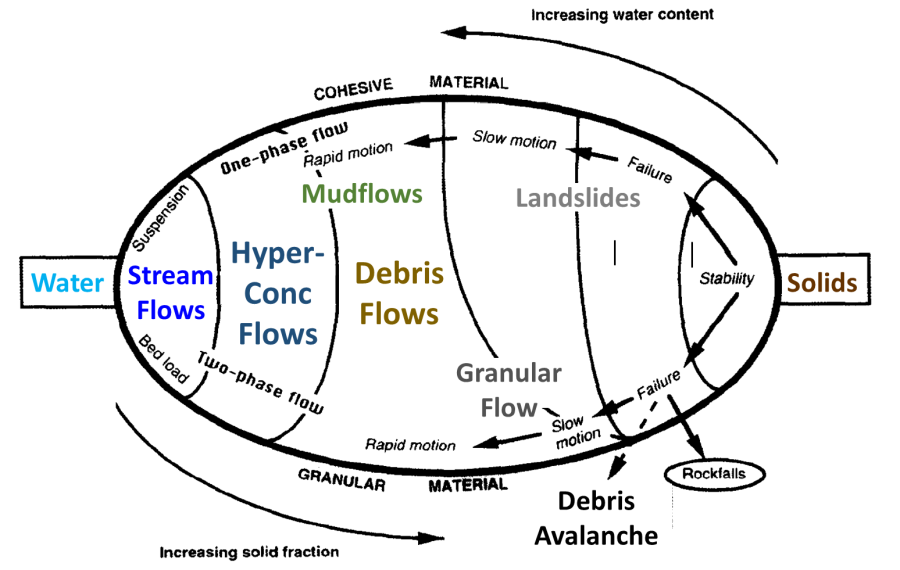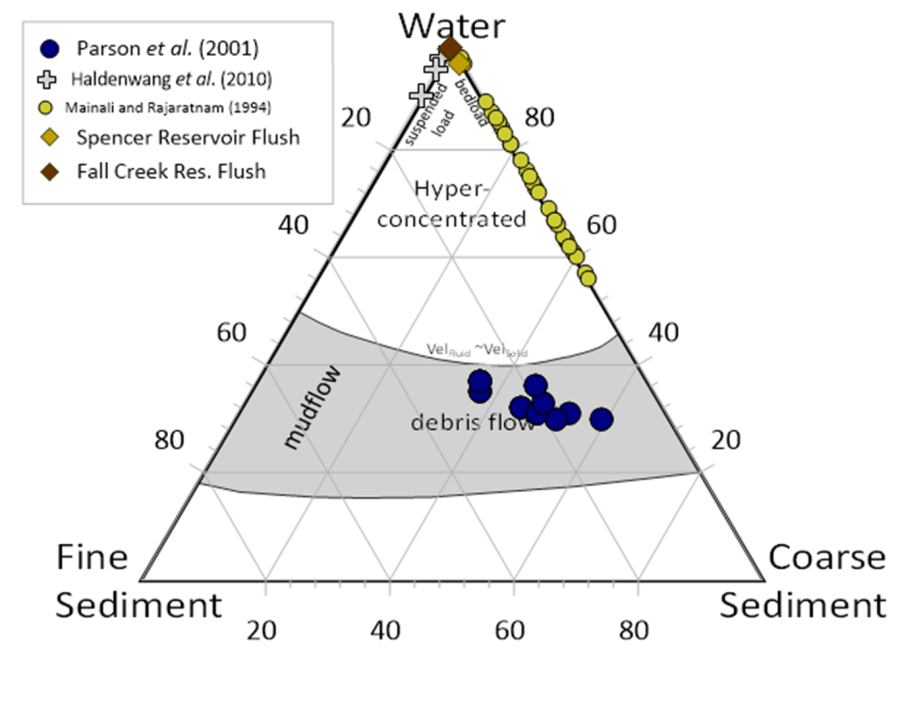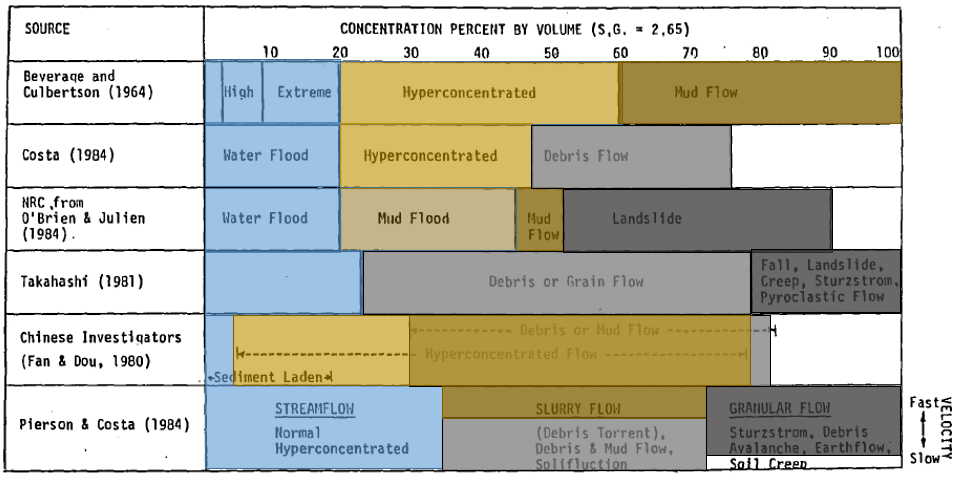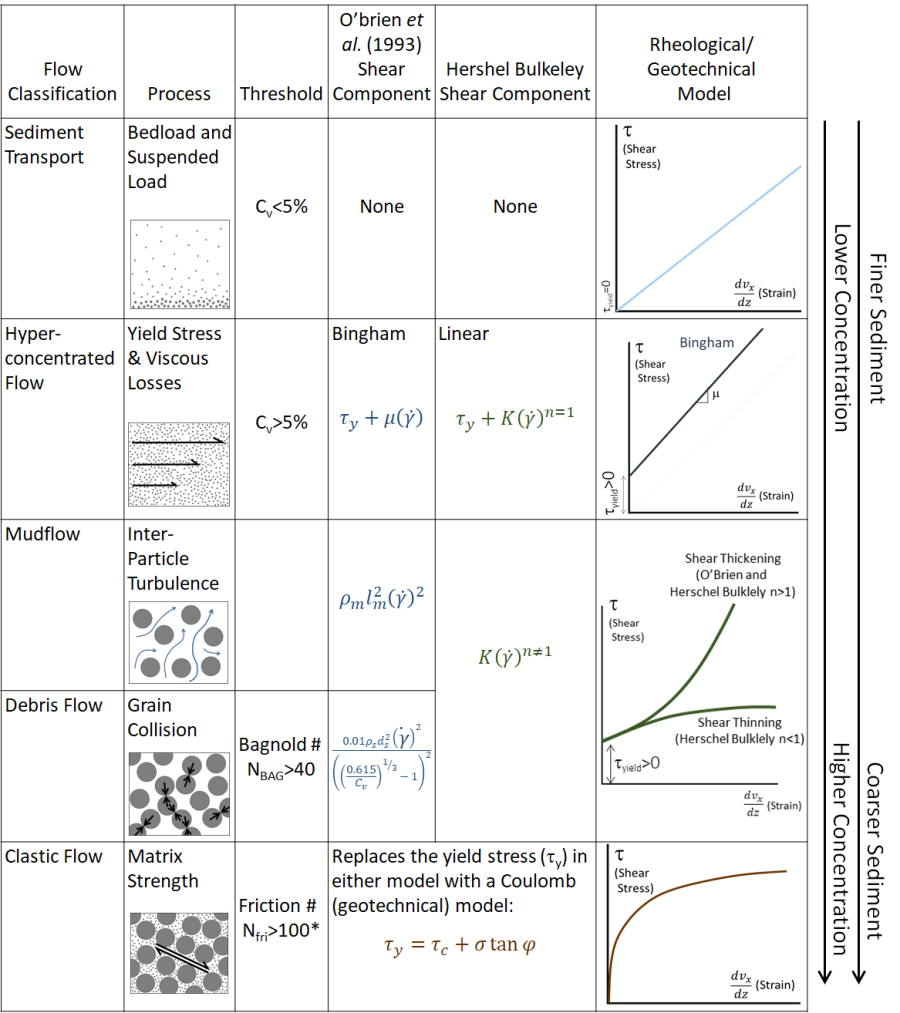Download PDF
Download page Introduction (Taxonomy and Rheology of Debris Flows).
Introduction (Taxonomy and Rheology of Debris Flows)
At very high solid concentrations fluids begin to depart from some of the basic hydraulic assumptions in HEC-RAS. In particular, post-wildfire storm events and mine-tailing dam breaches tend to carry enough sediment and other solids to change the flow physics and make the “Newtonian” fluid assumptions used throughout HEC-RAS inappropriate. The Mud and Debris module in HEC-RAS uses DebrisLib (Floyd et al., 2019) to account for internal losses that affect these high-concentration flows, and applies non-Newtonian models in HEC-RAS.
There are a range of approaches to simulating non-Newtonian fluids including single-phase and multi-phase approaches. The current capabilities in HEC-RAS use single phase approaches, which model fluid behavior with rheological models (i.e. stress-strain relationships).
Incorporating Non-Newtonian Effects into the Hydraulic Equations
The momentum equation is:

(where Sf stands in for all of the dimensionless loss "slopes" in Newtonian simulations including expansion and contraction and wind). The single-phase approach to mud and debris flow, simply adds another dimensionless loss slope, a mud and debris slope (SMD):

Casting the non-Newtonian effects as a "friction" slope is the mathematical move that allows us to import rheological "Rheology" is simply the study of how materials deform under stress. Here it is just short hand for "theoretical stress-strain relationships" like those in the right column of Figure 3-1. theory into the momentum equation, because we can connect this term to the expected stress-strain behavior of different materials.
The equation for shear stress is:

Where γ is the unit weight of the fluid, R is the hydraulic radius and Sf is the friction slope.
Therefore, the friction slope can be expressed as a function of the shear and two known or specified variables:

We can compute the Mud and Debris slope the same way, so it is proportional to an internal shear stress (by the ratio of variables known or specified in the model):

If we can express the internal losses of the fluid in terms of an internal shear stress, we can incorporate those effects into the momentum equation in HEC-RAS. These shear stresses come from Rheological models.
Rheology (Stress-Strain Relationships) of Non-Newtonian Fluids
Rheology is the study of how materials deform under stress. So "rheological models" are often expresses as simple relationships between stress and strain. Standard hydraulic models already assume a rheological model for hydrodynamic simulations. They assume that water begins to "deform" (movement or strain) under any stress (zero intercept on the stress-strain relationship), the strain increases linearly with the stress, and the water viscosity is the ratio between stress and strain (left pane of the Figure below). These are the assumptions of "Newtonian" flow.

Figure: Rheological models used to simulate (a) clear water and (b,c) mud and debris flows.
When fluids diverge from these assumptions including a non-zero stress-strain intercept (see center pane of above Figure) or a non-linear stress-strain relationship, or both (see right pane of figure above).
The Technical Reference Manual includes a detailed description of how the non-Newtonian terms fit into the unsteady flow equations in HEC-RAS. But the basic idea is that HEC-RAS adds an additional dimensionless "loss slope" to the friction slope that calculates friction losses in the Newtonian momentum equation in HEC-RAS.
Taxonomy of Mud and Debris Flows
These high-concentration flows do not all depart from the Newtonian assumptions in the same way. As concentration increases, and particle interactions become more important to the fluid energy losses. But the size of the solids also affects the rheological properties of the fluid. Because of this complexity, the categories and taxonomy of natural and anthropogenic non-Newtonian flows can be confusing. The interacting effects of concentration and grain size are both captured in the taxonomies in Different practitioners and agencies might use the terms "debris flow," "mud flow," Hyperconcentrated flow," "land slide" and "avalanche" to refer to different and overlapping processes.
Figure: Coussot and Meunier's (1986) taxonomy of Geologic flows.
Figure: Data sets used to test the HEC-RAS non-Newtonian model plotted on a modified version of the Philip and Davies (1991) taxonomy (from Gibson et al., 2020 in revision).
The taxonomy of debris flows can be confusing, as different disciplines, agencies, and publications describe the range of geophysical flows differently.

Figure: Various taxonomies of geopysical flows illustrating the diversity of deffinitions (modified from Philips (1888) after Bradley and McCutcheon, 1985)).
Because the geophysical flows we would like to model with HEC-RAS have different rheological frameworks, HEC-RAS follows the taxonomy in DebrisLib (see Figure Below). DebrisLib is a non-Newtonian, mud and debris flow library that HEC developed jointly with ERDC-CHL. Most USACE models use DebrisLib for these calculations, including HEC-RAS, HEC-HMS, ADH. As the sediment load increases and gets coarser, the flow transitions from Newtonian, to hyperconcetrated, mud, debris, and finally clastic "flows". The rheological models also progress from Newtonian, to Bingham (linear with a Yield Stress) to various non-linear models, and finally as the dominant internal loss process transitions from inter-particle collisions to inter-particle friction, DebrisLib includes geotechnical approaches to account for those processes.

Figure: Non-Newtonian flow taxonomy, with the rheological models and equations used to model them (from Gibson et al., 2020).